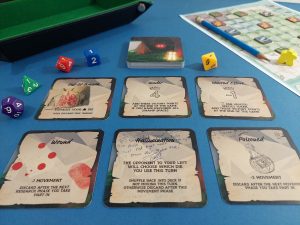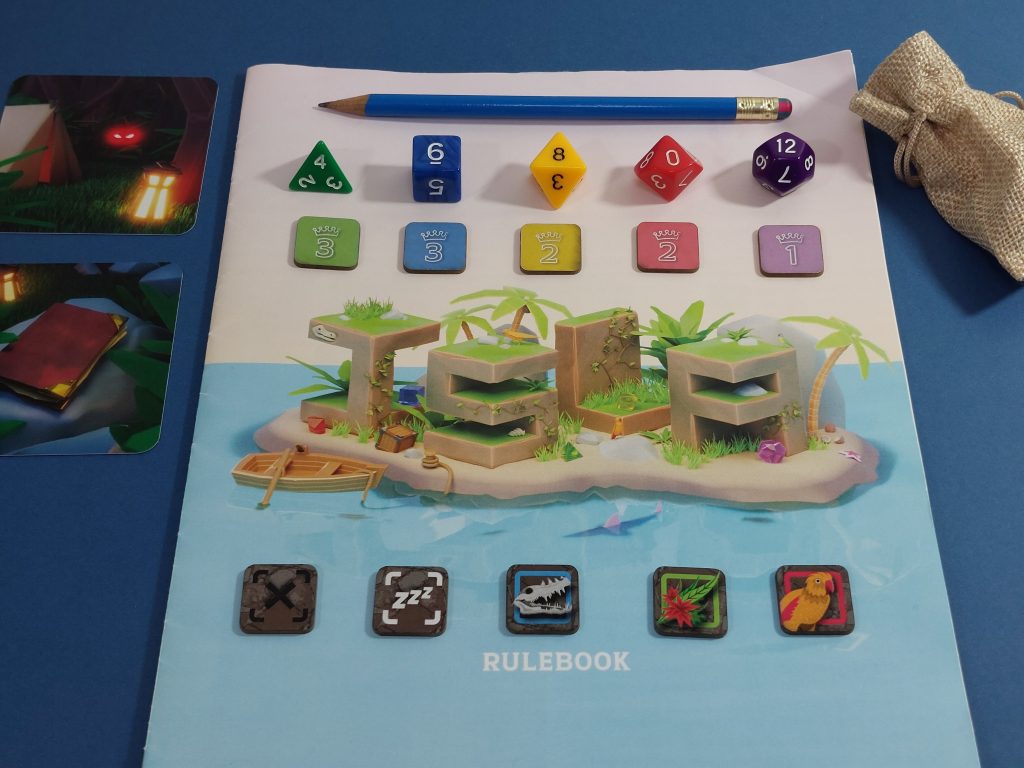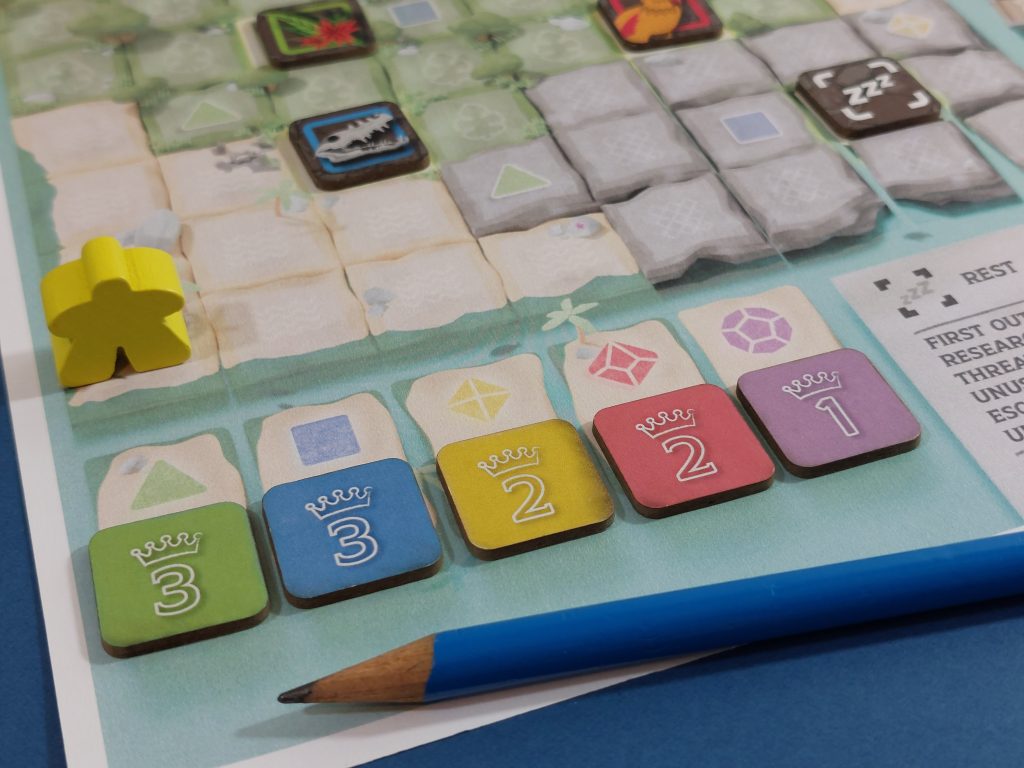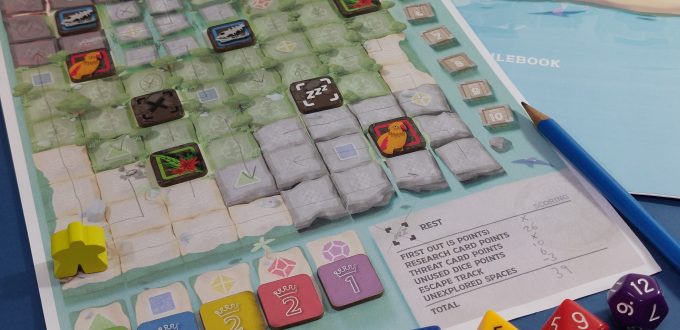Bury Board Games is out and about exploring ISLA by Ocean City Games! How far did he get in his intrepid travels? Let’s find out!
Publisher: Ocean City Games
Designer: Oleta Forde, Aaron Grove, Alexander Lucas
Artist: N/A
Release date: 2024
Player Count: 1-4 Players
Time: 30-60 minutes
Score 8.5/10
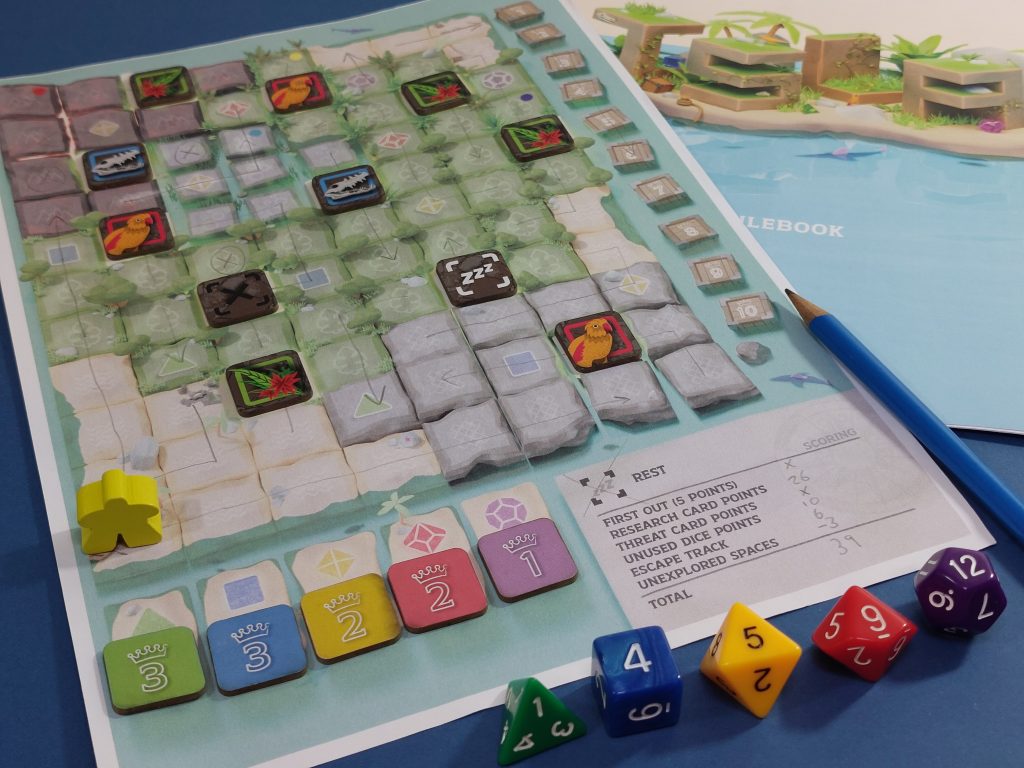
You’ve washed ashore on a strange island. You sense the promise of wondrous flora, fauna and fossils. What will you discover? How much of this island will you explore? But how long can you carry on along paths anew, before falling to exhaustion?
That’s Isla in a nutshell, an up-and-coming pencil-and-paper roll-and-write from Ocean City Games. On the surface, the gameplay seems simple. Pick one of five dice, move adjacent spaces equal to the die’s current value. Don’t re-tread over any paths you’ve already walked along. But the ‘exhaustion’ mechanism is a constant thorn in your side, if you want to ever escape this island. And like all good games, it’s the subtle puzzles you discover along the way that makes for marvellous gameplay…
This Is A Preview Prototype… And A Good One, At That!
First things first: this preview of Isla is a prototype, and not 100% the finished article. I sense it’s super-close to full completion, design-wise. But as always with preview copies: please take this into consideration!
The copy I received as a preview came with A4 player sheets. The first thing I took from this is, “That’s much larger than most standard roll and writes.” This is for scaling purposes, one assumes. The island is a 8×11 rectangular grid. 11 of the 88 squares have thick borders around them, spread throughout the island. Each player has 11 square Map Tokens, that they mix up and place down on these spaces. This means everyone’s tokens will be in different spots compared to one another.
Your 11 Map Tokens comprise of: 4x Flora, 3x Fauna, 2x Fossils, 1x Quick Rest, and 1x Boulder. In an ideal scenario, you’ll want to hoover up the first 10 of them. The Boulder is an obstacle though, which you cannot travel across. What if the sheet was more akin to other roll and write games (A5-sized, or even A6), then? Due to scale, the size of these tokens would have been small on a farcical scale! So I didn’t have a problem with the size of Isla’s sheets at all. In fact, I preferred it. And playing with my 9 year-old niece, A4 felt like a great size for her.
Players also have 5x Exhaustion Tokens, which sit at the bottom of your sheet. They line up partnered with their corresponding polyhedral die (d4/d6/d8/d10/d12). Each player also gets a meeple of their colour, who starts in the bottom-left square of the island grid. Your aim is to travel as much of the island as possible, before exiting via the top-right square.
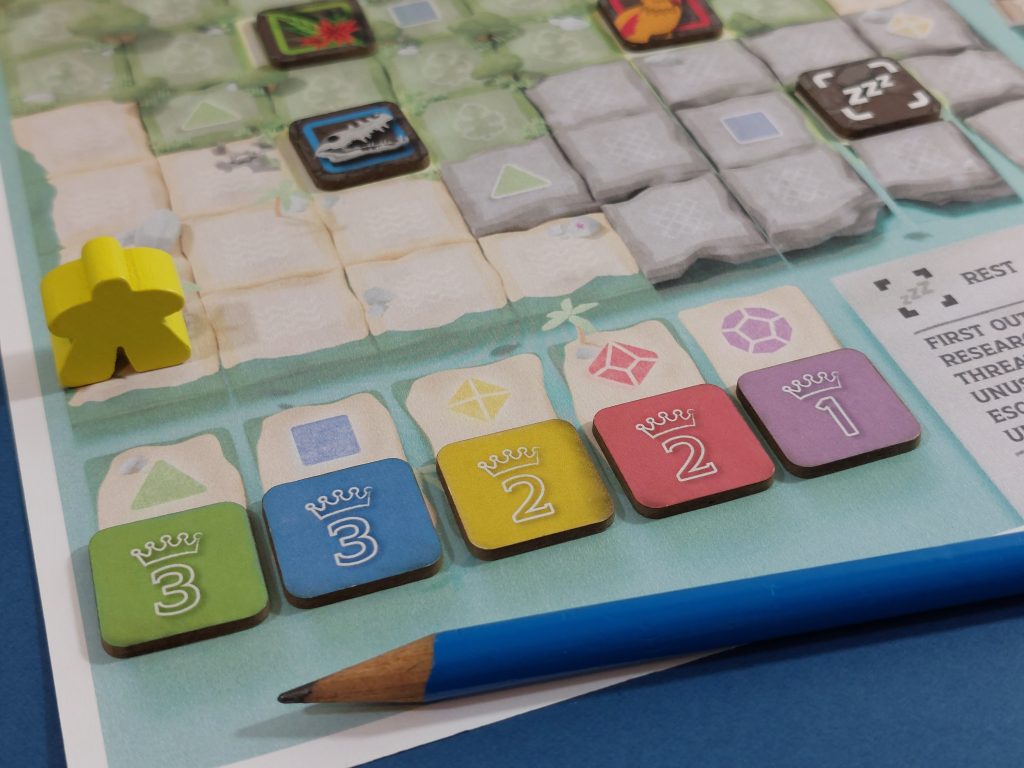
A Throwback To Nokia’s Snake
You lose 1 point for each square you failed to explore at the end of the game. And you can never explore the same square twice, so in some ways Isla is a throwback to Snake (remember that, Nokia phone-owners?). There’s other ways to score points, but I’ll explain them in due course. First, let’s look at how you move around the island…
At the start of each turn, players all take turns declaring whether they will Rest, Explore, or Research. Most of the time, players will opt to take the Explore action, so let’s discuss that, first.
Explore means picking one of the five dice that got rolled this turn. You then move x number of spaces (x being equal to the die’s face value). You draw a line that exact spaces to adjacent squares in your grid, as if you’d walked it. You cannot move diagonal, only orthogonal. Then you ‘exhaust’ that die by moving your corresponding Exhaustion Token so it covers the matching die. When it comes to Exploring, you can never pick a die if it is already exhausted.
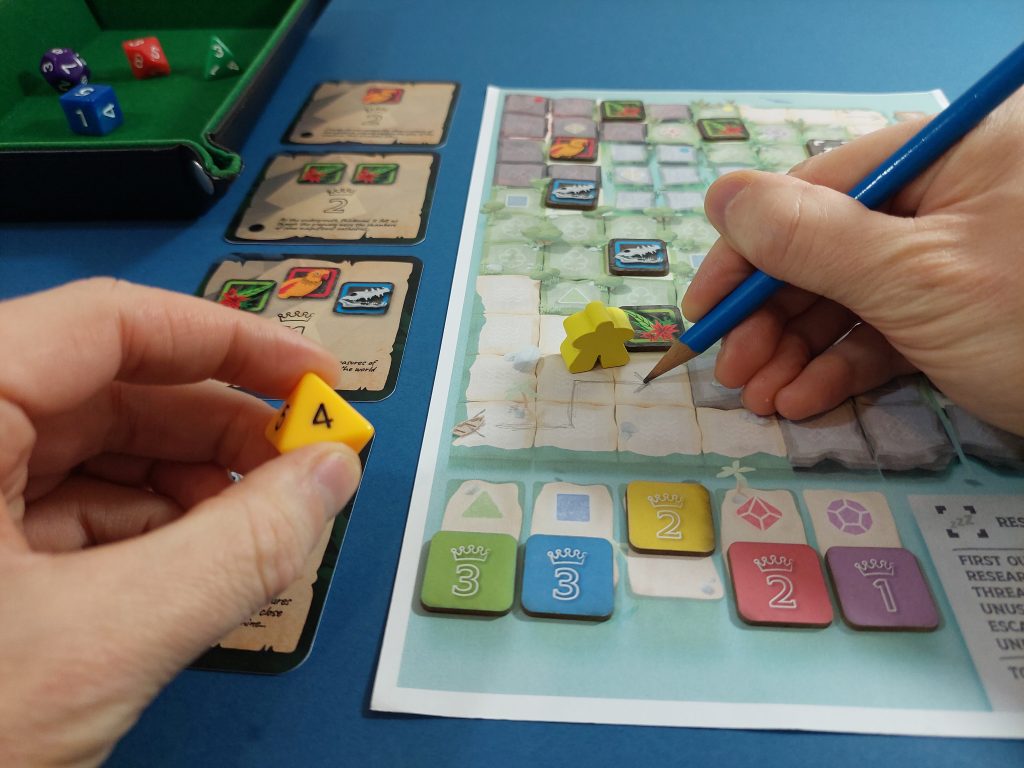
Managing Your Fatigue Levels
Option two – Rest – is a once-per-game option. You tick it off on your sheet and you gain back your left-most exhausted die. “Hang on, then…” I hear you query. “Does that mean the game is only six turns? Where I spend my five dice one at a time, and then get one back via a Rest?”
No! Isla is full of marvellous treats, if only you know where to look. On some island spaces, you’ll see some of the polyhedral dice icons. (The triangle for the d4; the ‘3D diamond’ for the d8, and so on.) Whenever you explore a square with one of these in it, you get to refresh the matching die again!
Isla avoids issues with colourblind players by having the dice as semi-silhouettes. That way it doesn’t over-rely on the d4 being green and the d8 being yellow, for example. Colourblind players can see the shape of the dice themselves, as well as the colour.
It goes without saying: if your path ventures over one of your 10x Map Tokens, you remove it from your sheet and keep it nearby (to use later). Remember, you can’t travel over the Boulder space! One of your Map Tokens is a ‘Quick Rest’ reward. You can discard it at any time to immediately refresh your left-most die.
The Rest options are clever, because of that ‘left-most’ caveat. The dice sit in numerical size order, of course, with the smallest die – the d4, numbered 1-4 – being on the left. Therefore the largest die, the d12 – with faces ranging all the way 1-12 – sits on the right. So the only way you’ll get to refresh your exhausted d12 is if it is the only die you’ve used at the time. (Because in that example it is, by default, the left-most exhausted die.)
Resting, then, is a question of good timing. Do you want to refresh the d4 and get to move another 1-4 spaces? Or the potential to move up to 12 spaces in one turn? I played Isla with my 9 year-old niece (who is also called Isla!) and she loved the puzzle of trying to ensure she used a die, and then refreshed it again as quick as possible. Isla, my niece, has already told me she wants to back Isla, the game, when it launches on Kickstarter in 2024!
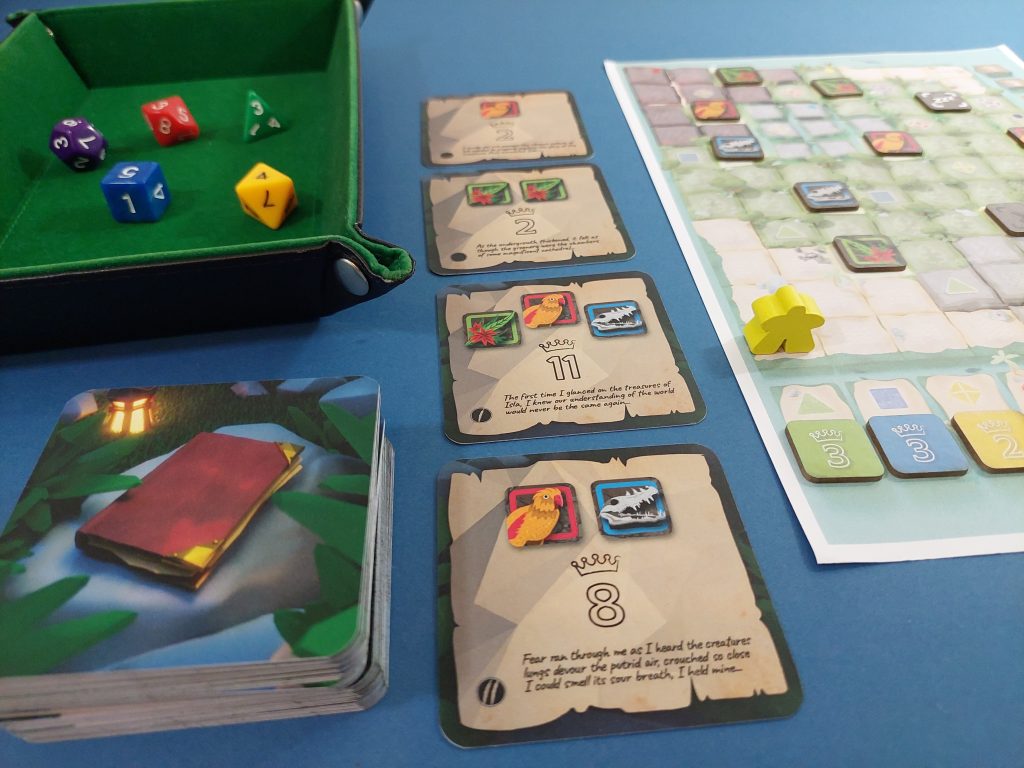
Research Isla’s Wildlife And Fossils
So what’s the deal with those Flora, Fauna and Fossil tokens? They’re to do with the third action you can take on your turn, which is ‘Research’. At the start of the game, four Research Cards get revealed, which are public and up for grabs. They all have a payment of a certain quota of these Species Tokens on them, and reward end-game points. These cards all have flavour text on them, which adds to the ambiance. Some players won’t even notice this, though!
If you already have the quota of tokens (by passing over them in previous turns), you can pay them in to claim that Research Card. That is, if you declared the Research action for the turn. Claiming happens in turn order, so that’s worth considering. Everything is public knowledge is Isla. You can guess when players will Research, because you can see their tokens. If you and another player both have the same tokens, only one of you can claim the Research.
Once claimed, all cards slide down one space and new card gets revealed. Plus, at the end of each round, the Research Card at the end of the row gets discarded. So if there’s one you have your eye on, you’d better act fast!
So turn order is important? In this aspect, yes. For the most part – Research Cards aside – Isla doesn’t have oodles of player interaction. But turn order plays a key role for another reason. When it’s your turn to be first player, you roll all the dice. If you roll any ones, that’s bad news! You have to take one Threat Card per 1 rolled. Sometimes you’ll get away with it… Other times you might roll multiple 1s!
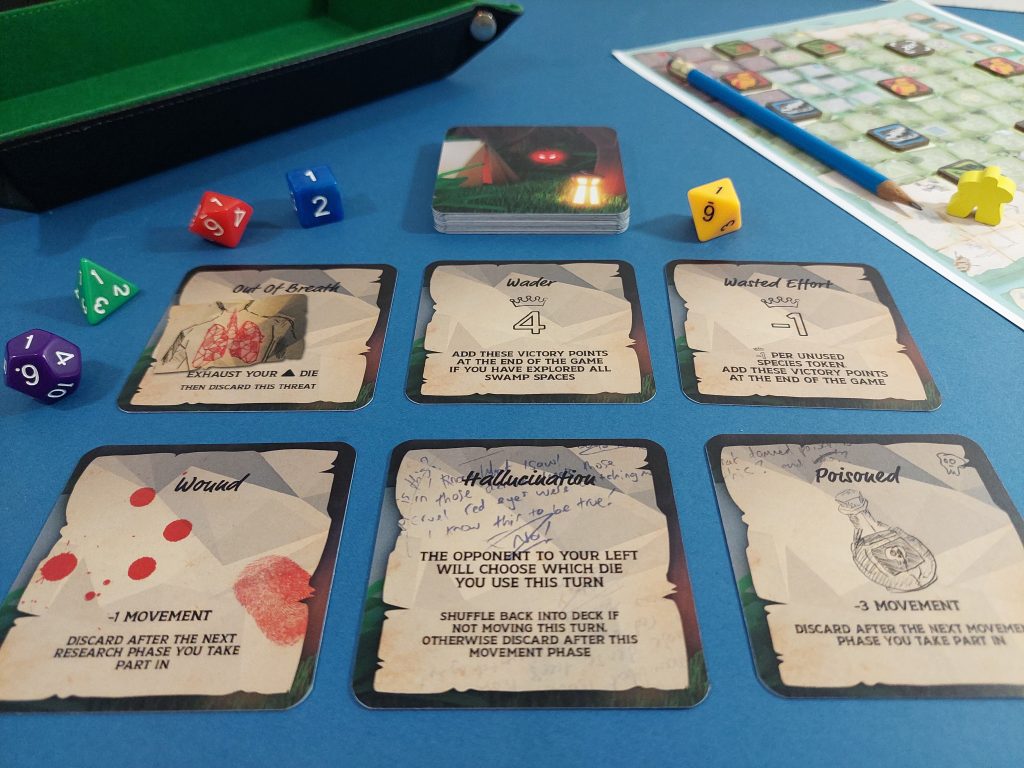
The Drama And Adrenaline Of Rolling Ones
Most of the Threat Cards are bad. Some of them are a movement penalty. One is a one-time negative of moving -3 this turn (so if you picked the d12, which rolled a 10, you’d only move 7 spaces). Others are far worse, such as the Wound card. I drew this on the very first turn of the game! It’s -1 movement on every turn until you participate in Research. This has the potential to be mega-harsh depending on a) the timing, such as the start of the game! And b) the layout of your Species Tokens.
Nobody at the table liked this Threat Card, because it felt so much more punishing than the others. We didn’t mind cards like Hallucination (where your neighbour picks your die this turn!). Thirsty (where one of your dice becomes Exhausted straight away) also felt an apt punishment. The reason we didn’t mind these were because they’re one-time penalties, not elongated ones. We actually rather enjoyed the ‘don’t roll a one!’ element to Isla. It adds a lot of drama into the proceedings! And in a four-player game, it doesn’t feel so bad. You only run this risk for one in every four turns, after all. It has the potential to be a lot tougher when you play with fewer players. In a two player game, for example, you spend a higher ratio of the time being the first player.
Some of the Threat Cards are, in fact, hidden positives, though. Some, like Wader, for example, actually reward you with points if you manage to explore all the Swamp spaces. (No points loss if you fail to do so… but a missed opportunity.) Swamps? Yes, that’s right: the island’s split up into five different terrains (if we include the beach itself). In some light, this can be a bit tough to distinguish. But remember, this is a prototype, so I’d assume the print quality will be much higher in the final product.
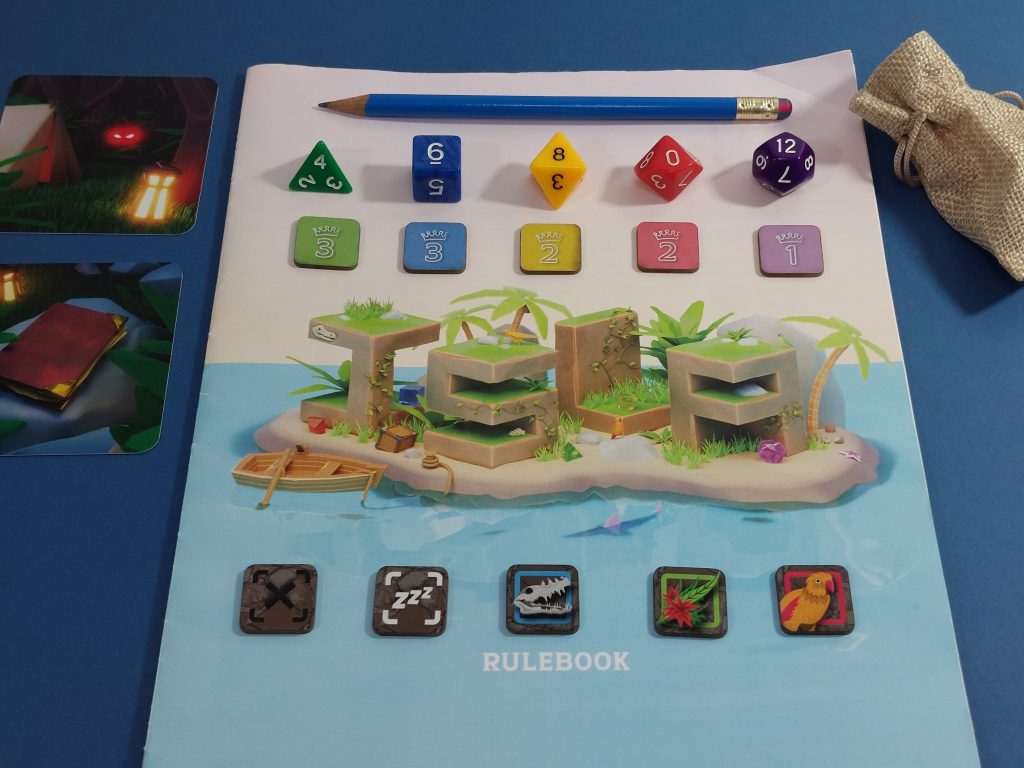
How Else Do You Score Points?
How else do you score points at the end, then? Well, first of all, the game end triggers once all players have either exited the island (via that space in the top-right corner). Or, if all player are fully exhausted of dice. (This means they can no longer move, and become ‘lost’ on the island.) It’s likely that some players will finish earlier than others.
If you’re the first player to exit the island, you gain a bonus 5 points. You add up the points for your Research Cards and Threat Cards. If you managed to escape, you gain extra points depending on how far you made it along the Exit Track. You could earn an additional 10 points for this, if you manage your dice towards the end of the game (using a high-face value d10/d12). There’s an element of luck to this aspect, though. (You could save your big die for it, only for it roll a 1 and there’s nothing you can do about it!)
You also earn points from any Dice Tokens you have left over, which are not exhausted. That’s what those big numbers are on the tokens, themselves! This felt less luck orientated, since with careful planning you know you’ve banked those points.
As I mentioned earlier, you lose 1 point for every unexplored space left on the island at the end. (This can be a painful result if you end up lost on the island, because in theory you’ll have left some of it unexplored!) Since you cannot explore the Boulder space, this is always going to be -1, at best. Navigating your way around your Boulder can be the difference between missing a chunk of the island, and not.

Final Thoughts On… Isla
Isla is a clever roll and write exploration game without being too much. I always felt like I was spinning a couple of plates rather than it being a one-trick pony. But at the same time, I didn’t ever feel overwhelmed. Some roll and writes have colossal cascading effects. Tick this, complete that, and this unlocks this ability, which lets you tick that, and then some other stuff happens! (Games like Demeter, or Ganz schon clever, I’m looking at you!)
That’s not the case in Isla. Yes, you’re spending dice, and then looking to try and run over paths to get them back. And you’re also trying to create constant motion by leaving no stone unturned. Plus you’re keeping an eye on the Research Cards, because they’re worth grabbing! But that didn’t ever feel like I was drowning, or forgetting to do/check off things on my sheet. Your goals are clear.
I’ll be the first to admit, I might be an anomaly within gaming: I like crunchy Euros, but I struggle with crunchy roll and writes. I prefer a crisper, cleaner pencil-and-paper experience. My brain doesn’t seem to focus that way! Isla is by no means an ‘easy’ roll and write, nor mega-complex, but it hit a perfect sweet spot for me. I thrived with the puzzle you’re aiming to try and solve. I’m also a huge fan of the fact it’s modular. Not only are you exploring a different island layout compared to your opponents. Also, your island’s 11x Tokens probably won’t be in these exact places next time you play, either.
The Research Cards are a cool conundrum, because some are worth more than others. This points value ratio is equal to how common the tokens are on your island. You only have 2x Fossils, so Research with Fossils in them are worth more than those with Flora in, for example. But the other gamble is you have to state whether you plan to Research or Explore before the dice get rolled. You might Research on a turn when the dice roll their maximums (such as a 12 on the d12), or vice versa! You know what they say when it comes to gambling on dice outcomes: the dice gods giveth, and the dice gods taketh away…
Ocean City Games suggest a game time of 30-60 minutes, which feels about right. It’s meant to be a simultaneous action game, where everyone responds to the dice rolled. The only turn order in terms of waiting is when it comes to claiming Research Cards. They also suggested 14+ as the recommended age, but I’d argue that my niece found it a wonderful experience! I’m excited to see Isla launch on Kickstarter in 2024. I’m hoping for beautiful polyhedral dice and custom meeples as component upgrades. But the gameplay itself, as it stands, is rock-solid, and provides a wonderful sense of achievement as you meander around this island
